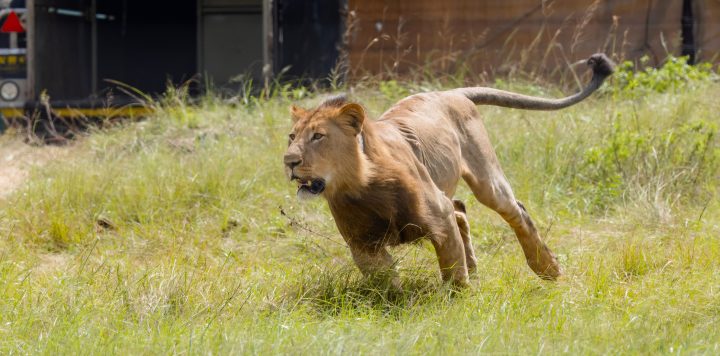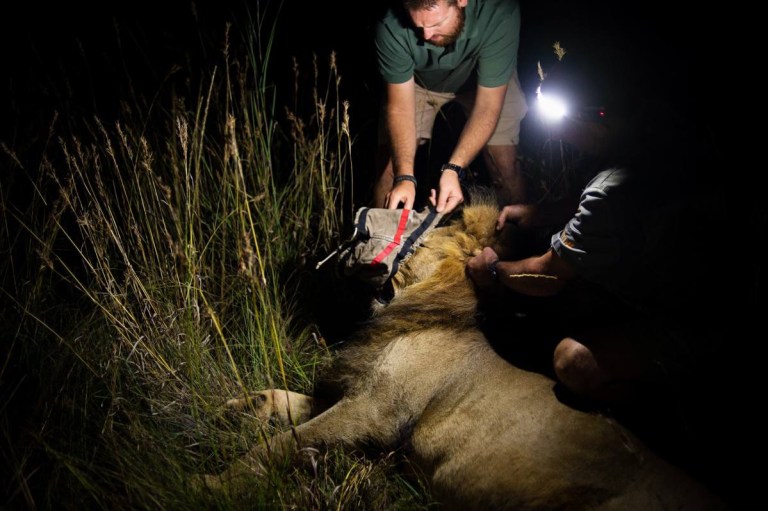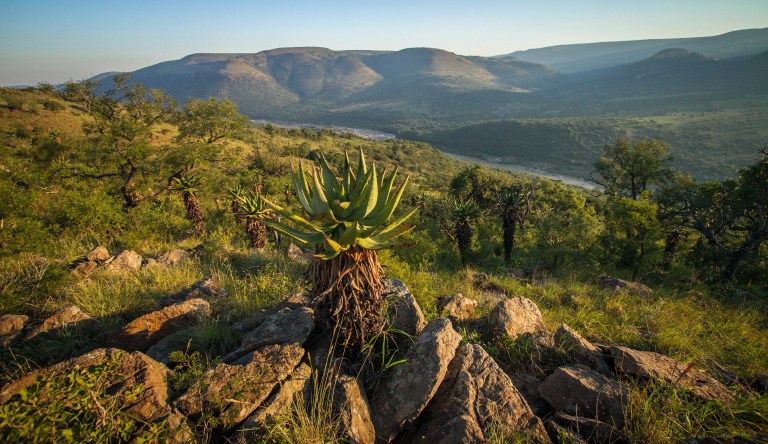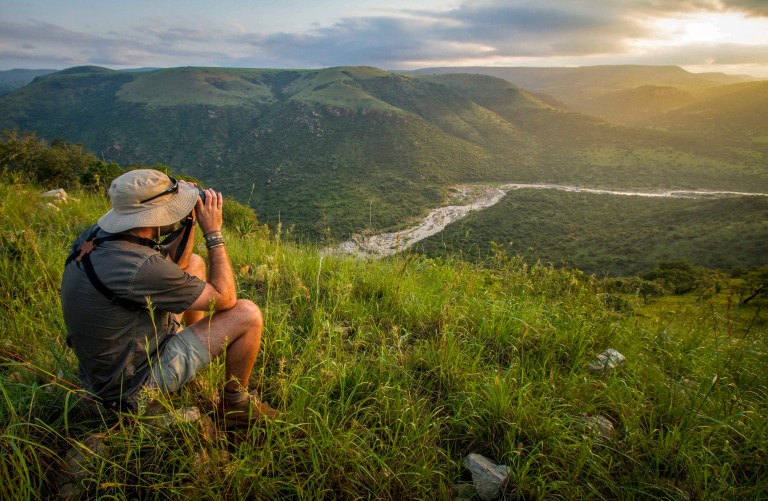New ‘wilderness development’ takes shape in the Zulu heartland – Babanango Game Reserve
 The reserve provides sanctuary to endangered species such as the black rhino. (Photo: Angus Burns / WWF)
By Tony Carnie | 01 Jul 2024
The reserve provides sanctuary to endangered species such as the black rhino. (Photo: Angus Burns / WWF)
By Tony Carnie | 01 Jul 2024
At a time when living space for wild creatures is being destroyed or degraded at an alarming pace, the restoration of a large new African landscape for nature conservation is a cause for celebration.
_________________________________________________________________________________________________________________________
This is particularly so when the project also aims to create jobs and economic upliftment for local landowners – without dynamiting or drilling into the earth to extract minerals and fossil fuels, or ripping the soil apart and dousing it with chemicals and fertilisers to develop large-scale crops or timber plantations.
Instead, the emphasis is on “rewilding” a degraded environment to secure more space for the multitude of non-human life forms squeezed from their habitats in the Anthropocene Era.
 A kudu bull peers warily from a thicket. More than 3,000 head of game have been reintroduced to the new reserve. (Photo: Angus Burns / WWF)
A kudu bull peers warily from a thicket. More than 3,000 head of game have been reintroduced to the new reserve. (Photo: Angus Burns / WWF)
 Giraffe nibble from a thorn tree in the early morning mist at Babanango Game Reserve. (Photo: Julian Hahne / WWF)
Giraffe nibble from a thorn tree in the early morning mist at Babanango Game Reserve. (Photo: Julian Hahne / WWF)
Such a task is easier said than done. Yet the developers of the new Babanango Game Reserve in northern KwaZulu-Natal seem to have made a good start.
Apart from hosting the Big Five, this 20,000ha reserve covers a significant chunk of land that encompasses the clean-flowing upper reaches of the White Mfolozi River and patches of rapidly disappearing mist-belt grasslands noted for their abundance of flowering plants and rare species.
 The waters of the White Mfolozi River still run clear in the upper reaches that pass through the reserve. (Photo: Angus Burns / WWF)
The waters of the White Mfolozi River still run clear in the upper reaches that pass through the reserve. (Photo: Angus Burns / WWF)
It was only officially proclaimed as a provincial reserve in November 2023, but reaching that point had taken several years.
Reserve manager Ryan Andraos recalls that most of the land in the current reserve was returned to its original owners following a series of land claims lodged nearly 20 years ago.
Located roughly halfway between the towns of Ulundi and Vryheid, the reserve is close to the historic Anglo-Zulu battlefields of Isandlwana and Rorke’s Drift, as well as Emakhosini (Valley of Kings), birthplace of the Zulu nation and the burial ground of several kings going back as far as the 1600s – including Zulu kaMalandela, Phunga, Mageba, Ndaba, Jama and Senzangakhona (father of the legendary Shaka).
There have been several efforts to establish a game reserve in the Babanango area since the early 1990s, but Andraos says conservation was on a downward spiral until a major German investor arrived in 2018.
This followed agreements largely brokered by the Conservation Outcomes group to consolidate several parcels of land – 13,000ha owned by the Emcakwini Community Trust; roughly 1,000ha owned by the Esibongweni and Kwangono communities, and two other areas owned by government and a private landowner.
 A wildlife ‘poacher’ flees from a Belgian Malinois K9 tracker dog during a simulated exercise by members of Babanango’s anti-poaching unit. (Photo: Julian Hahne / WWF)
A wildlife ‘poacher’ flees from a Belgian Malinois K9 tracker dog during a simulated exercise by members of Babanango’s anti-poaching unit. (Photo: Julian Hahne / WWF)
Significantly, 74% of the new reserve is owned by local communities.
But stitching together such a game reserve and getting buy-in from everybody is never easy, considering complex issues such as livestock grazing rights or reaching a consensus about rival land use options.
One recent example of the failure of a community-owned conservation venture comes from the Mayibuye Game Reserve near Camperdown, which has all but collapsed amid community conflict and divisions.
Nevertheless, Conservation Outcomes director Chris Galliers points to examples of much more successful community conservation in KwaZulu-Natal, such as the 12,000ha Somkhanda Game Reserve near Mkuze and the 10,000ha Nambiti Private Game Reserve in the Thukela Valley.
 The sun lights up the clouds above Babanango, a new community-owned wildlife game reserve near Ulundi. (Photo: Angus Burns / WWF)
The sun lights up the clouds above Babanango, a new community-owned wildlife game reserve near Ulundi. (Photo: Angus Burns / WWF)
 A party of visitors on a game drive negotiate a rocky river crossing. (Photo: Angus Burns / WWF)
A party of visitors on a game drive negotiate a rocky river crossing. (Photo: Angus Burns / WWF)
 The main viewing deck at the reserve’s Madwaleni River Lodge overlooks the upper section of the White Mfolozi River, which gets its name from the light-coloured granitic rocks of the area. (Photo: Angus Burns / WWF)
The main viewing deck at the reserve’s Madwaleni River Lodge overlooks the upper section of the White Mfolozi River, which gets its name from the light-coloured granitic rocks of the area. (Photo: Angus Burns / WWF)
Galliers and his colleagues provide support to private and communal landowners to develop new biodiversity conservation projects at a time when many provincial and state-owned reserves are floundering due to funding and staff cutbacks.
He says the organisation’s philosophy is based on the premise that conservation can compete very effectively with other forms of land use, including agriculture, particularly in the historically poor rural areas of South Africa.
“Conservation can provide meaningful economic development and employment opportunities for communities through activities such as ecological restoration, tourism, hunting and venison production.”
However, getting such ventures out of the starting blocks requires money and other forms of legal, technical, management or training support.
 Hellmuth Weisser says he has spent close to R1bn developing tourism lodges and other visitor infrastructure at Babanango. (Photo: Angus Burns / WWF)
Hellmuth Weisser says he has spent close to R1bn developing tourism lodges and other visitor infrastructure at Babanango. (Photo: Angus Burns / WWF)
Much of that crucial support for Babanango arrived six years ago when Hamburg-based investor Hellmuth Weisser began to pump funds into the new reserve. This has included building three new tourist lodges, erecting an extensive game-proof fence, upgrading roads and bridges and re-stocking the reserve with wildlife.
So far, more than 3,000 head of game have been released into Babanango, ranging from the iconic Big Five attractions to less-famous species such as oribi, klipspringer and African rock pythons.
Apart from white rhinos, there is also a small group of the more endangered black rhino species. Africa’s black rhino numbers crashed dramatically, from more than 60,000 in the 1960s to around 2,500 in 1992. They have subsequently increased to around 6,500, but are by no means out of the woods.
To change this picture, the WWF conservation organisation has been shifting small groups of black rhinos out of state-managed reserves on to suitable private and communal land for more than 20 years.
Ursina Rusch, population manager for the WWF Black Rhino Range Expansion Project, says 17 new breeding areas (covering 360,000ha) have been established over the past two decades, aiming to achieve a 5% annual increase in the population.
 A maned lion peers from the long grass in the new 20,000ha Big Five game reserve. (Photo: Angus Burns / WWF)
A maned lion peers from the long grass in the new 20,000ha Big Five game reserve. (Photo: Angus Burns / WWF)
The objective is to increase the available habitat for this species, thereby allowing the animals to multiply more rapidly. It’s a slow process, but the first black rhino was born in Babangango last year, while the first lion cub was born here in June.
What’s in it for the people who now own this land or live nearby?
 Community liaison officer Thokozani Hlophe welcomes visitors to the newly opened ranger base. (Photo: Angus Burns / WWF)
Community liaison officer Thokozani Hlophe welcomes visitors to the newly opened ranger base. (Photo: Angus Burns / WWF)
Thokozani Hlophe, community liaison officer for the African Habitat Conservancy Foundation, says the most tangible benefits so far have been the creation of 210 permanent jobs, along with annual leasehold income for the three community trusts and preferential employment for land claim beneficiaries.
As part of the 32-year lease agreement, the conservancy foundation was set up to initiate and support several sustainable development initiatives for communities living within a 10km radius.
 Chef Njabulo Mthethwa and colleague Zinhle Ntombela serve breakfast at the Madwaleni River Lodge. (Photo: Tony Carnie)
Chef Njabulo Mthethwa and colleague Zinhle Ntombela serve breakfast at the Madwaleni River Lodge. (Photo: Tony Carnie)
 Members of the Babanango anti-poaching unit on parade. (Photo: Julian Hahne / WWF)
Members of the Babanango anti-poaching unit on parade. (Photo: Julian Hahne / WWF)
This has included vocational training in the conservation and hospitality sector; new solar-powered boreholes for fresh water; Wi-Fi connections for local schools, reading glasses for the elderly and entrepreneurship projects such as vegetable gardens or chicken husbandry.
Weisser, the retired chairman of the global energy, chemicals and petroleum storage group, Marquard & Bahls AG, estimates that he has invested close to R1-billion in the development of Babanango.
“I can assure you that this investment is not about making money. It is a project of passion… a thing of the heart,” Weisser said during a recent media tour to Babanango.
“We are a bit crazy. My wife and I love Africa after visiting here often over the last 20 years. So, when we were looking to invest money in a conservation project in Africa, we chose Babanango because this project made the most sense to us.
“It ain’t easy all the time. There is also some history,” he said, noting that relations between some of the local communities and former landowners had not always been smooth in the past. DM
The writer was a guest of WWF and Babanango Game Reserve.




















